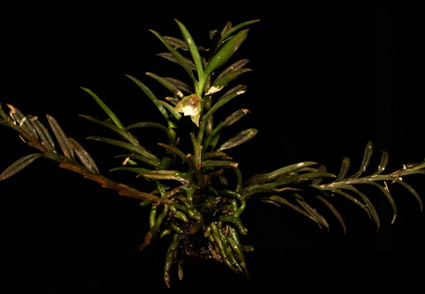Abstract
In this article we first propose to treat Dichaea integrilabia and D. saraca-taquerensis as synonyms based on analysis of the types, original descriptions and other material conserved in Amazonian herbaria. We also better address the taxonomic issues relating to D. fusca and D. weigeltii which have been wrongly considered as synonymous species. Besides we document the geographical expansion of D. fusca to the state of Pará (Brazil) whereas it was hitherto thought to be restricted to the state of Amazonas (Brazil). For both taxa (D. saraca-taquerensis and D. fusca) we give a taxonomic description, a photograph plate, information about the geographical distribution (with a map) as well as a preliminary conservation status according to IUCN criteria.
References
- Bachman, S., Moat, J., Hill, A.W., De La Torre, J. & Scott, B. (2011) Supporting Red List threat assessments with GeoCAT: Geospatial conservation assessment tool. ZooKeys 150: 117–126. https://doi.org/10.3897/zookeys.150.2109
- Campacci, M.A. & Silva, J.B.F. (2015) Dichaea saraca-taquerensis. Coletânea de Orquídeas Brasileiras 11: 410–413.
- Chase, M.W., Freudenstein, J.V., Cameron, K.M. & Barrett, R.L. (2003) DNA data and Orchidaceae systematics: a new phylogenetic classification. In: Dixon, K.W., Kell, S.P., Barrett, R.L. & Cribb, P.J. (Eds.) Orchid conservation. Natural History Publications, Kota Kinabalu, pp. 69–89.
- Cogniaux, A. (1906) Orchidaceae III, Dichaea. In: Martius, C.F.P., Eichler, A.G. & Urban, I. (eds.) Flora Brasiliensis. Fleischer, Munich, pp. 484–504.
- Dodson, C.H. (2004) Orquídeas Nativas do Equador. Volume V. Rodriguezia–Zygosepalum. Dodson Publishing, Flórida, 232 pp.
- Dressler, R.L. (1993) Phylogeny and Classification of the Orchid Family. Dioscorides Press, Portland, 314 pp.
- Gonçalves, E.G. & Lorenzi, H. (2007) Morfologia Vegetal: Organografia e Dicionário Ilustrado de Morfologia das Plantas Vasculares. Instituto Plantarum de Estudo da Flora, São Paulo, 416 pp.
- Govaerts, R., Dransfield, J., Zona, S., Hodel, D.R. & Henderson, A. (2023) World Checklist of Orchidaceae. Facilitated by the Royal Botanic Gardens, Kew. Available from: http://apps.kew.org/wcsp/ (accessed: 6 August 2023).
- Harris, J. & Harris, M. (2001) Plant identification terminology: An illustrated glossary. Spring Lake Publishing, Payson, 260 pp.
- IUCN (2022) Guidelines for Using the IUCN Red List Categories and Criteria. Version 15.1. Prepared by IUCN Standards and Petitions Committee. Available from: http://www.iucnredlist.org/ (accessed: 6 August 2023).
- Krahl, A.H., Valsko, J.J. & Holanda, A.S.S. (2014) Uma nova espécie de Dichaea Lindl. (Orchidaceae) para a Amazônia brasileira. Boletim do Museu Paraense Emílio Goeldi, Ciências Naturais 9: 677–683. https://doi.org/10.46357/bcnaturais.v9i3.517
- Krahl, A.H., Valsko, J.J., Holanda, A.S.S. & Chiron, G. (2016) A new species of Dichaea (Orchidaceae) from Brazil with special reference to its foliar anatomy. Phytotaxa 265: 145–150. https://doi.org/10.11646/phytotaxa.265.2.6
- Kuntze, C.E.O. (1904) Dichaea. In: von Post, T.E. (Ed.) Lexicon Generum Phanerogamarum. Stuttgart, Deutsche Verlags-Anstalt, pp. 709.
- Lindley, J. (1833) The Genera and Species of Orchidaceous Plants. Ridgways, London, 554 pp.
- Meneguzzo, T.E.C. & Hall, C.F. (2023) Dichaea. In: Flora e Funga do Brasil. Jardim Botânico do Rio de Janeiro, JBRJ. Available from: https://floradobrasil.jbrj.gov.br/FB11458 (accessed: 6 August 2023).
- Neubig, K.M., Williams, N.H., Whitten, W.M. & Pupulin, F. (2009) Molecular phylogenetics and the evolution of fruit and leaf morphology of Dichaea (Orchidaceae: Zygopetalinae). Annals of Botany 104: 457–467. https://doi.org/10.1093/aob/mcp004
- Pfitzer, E.H.H. (1887) Entwurf einer natürlichen Anordnung der Orchideen. Carl Winter’s Universitätsbuchhandlung, Heidelberg, 187 pp. https://doi.org/10.5962/bhl.title.166408
- Reichenbach, G.H. (1859) Orchideae Splitgerberianae Surinamenses. Nederlandsch Kruidkundig Archief 4: 319–335
- Schweinfurth, C. (1952) Dichaea tenuis. American Orchid Society Bulletin 21: 510.
- Schweinfurth, C. (1961) Orchids of Peru, part 4. Fieldiana, Botany 30: 787–1026.
- Thiers, B.M. (ed.) (2023) [continuously updated] Index Herbariorum: A global directory of public herbaria and associated staff. New York Botanical Garden’s Virtual Herbarium. Avaiable from: http://sweetgum.nybg.org/ih/ (accessed: 6 August 2023).
- Valsko, J.J., Krahl, A.H., Holanda, A.S.S. & Bolsanello, R.X. (2014a) A new species of Dichaea (Orchidaceae) from the Amazon Region of Brazil. Richardiana 14: 131–139.
- Valsko, J.J., Krahl, A.H., Holanda, A.S.S. & Zartman, C.E. (2014b) A new species of Dichaea (Orchidaceae) for northern Brazil. Acta Amazonica 44: 397–402. https://doi.org/10.1590/1809-4392201305162
- Whitten, W.M., Williams, N.H., Dressler, R.L., Gerlach, G. & Pupulin, F. (2005) Generic relationships of Zygopetalinae (Orchidaceae: Cymbidieae): combined molecular evidence. Lankesteriana 5: 87–107. https://doi.org/10.15517/lank.v5i2.19799


